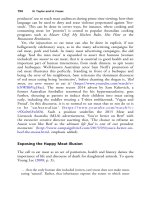The palgrave international handbook of a 344
Bạn đang xem bản rút gọn của tài liệu. Xem và tải ngay bản đầy đủ của tài liệu tại đây (27.44 KB, 1 trang )
342
C. Lawson
strength and demeanour. Their ability to protect and fight successfully for
their keeper as well as in large-scale military campaigns (see also chapter on
Animals in War) and competitive entertainment made them very attractive
(Fleig 1996). This resulted in selective breeding for the anatomical traits
perceived to provide the best performance in the ring, married with the aim
to produce a dog that was human-friendly but aggressive to its own species
and often other animals. The USA imported dog fighting from the UK in
the early 1800s and through selective breeding created the American pit bull
terrier, although the Staffordshire bull terrier and other related bull terriers
also continued to be used. These dogs were attractive, and remain so, to dog
fighters for their compact size, agility, ‘gameness’, strength and lack of
threat-displays. But despite these breeds being carefully bred for docility
towards humans—perhaps further than that, a strong social bond with
humans (McMillan and Reid 2009)—their use in fighting led to many
US states, followed by other countries, including the UK (s1 of the
Dangerous Dogs Act 1991), introducing breed specific legislation to ban
ownership across the whole of society. The intention to eradicate the various
breeds banned under this type of legislation—most famously the pit bull
terrier—has rather conspicuously failed, nevertheless, there has, undoubtedly,
been consequences for these types of dog. This is discussed further in the
chapter on Status Dogs (herein).
The offences related to dog fighting and indeed all animal fighting in
the UK are now contained within s8 of the Animal Welfare Act (2006).
Harding and Nurse (2015) suggest that the lack of a separate offence for
dog fighting is problematic primarily because dog fighting is indiscernible
from other animal fighting offences and the variation which exists in the
level of offending and the type of offender is invisible in data recorded
under s8. While there is no corresponding reference to such a problem
made by investigators and enforcers (Lawson forthcoming), there is consensus that the problem of identifying and recording dog fighting is
inherently linked to the legislation, and the offences contained within,
which does not provide for a clear data set. This issue is as much to do
with the fact, however, that the majority of enforcement is conducted by
the RSPCA, and the UK Government is not required to record and report
on these private prosecutions. In the USA, dog fighting was not made
illegal in all states until 1976 and it was not a felony in all states (and at a
federal level) until the last decade. In addition some states still regard
spectating as a mere misdemeanour (Gibson 2014). In most states the
situation can be considered to be similar to that of the UK whereby the
offences relating to dog fighting are contained within a broader category of









